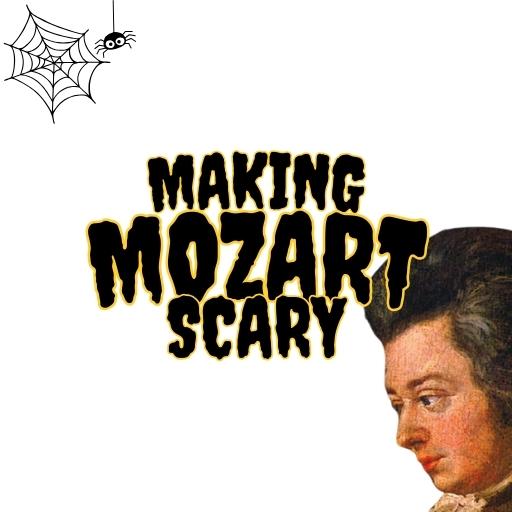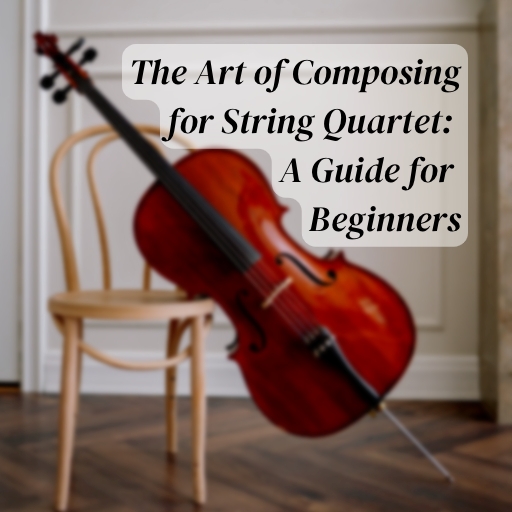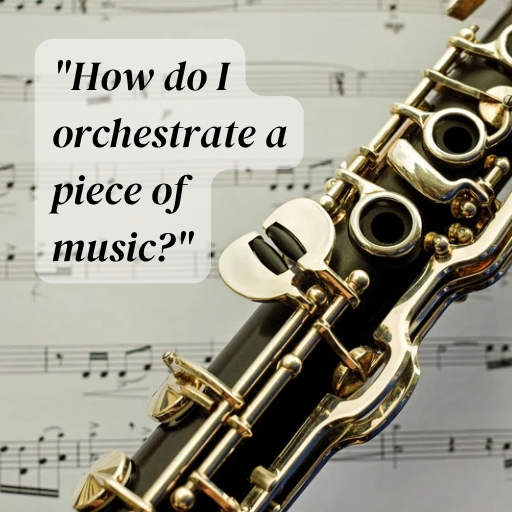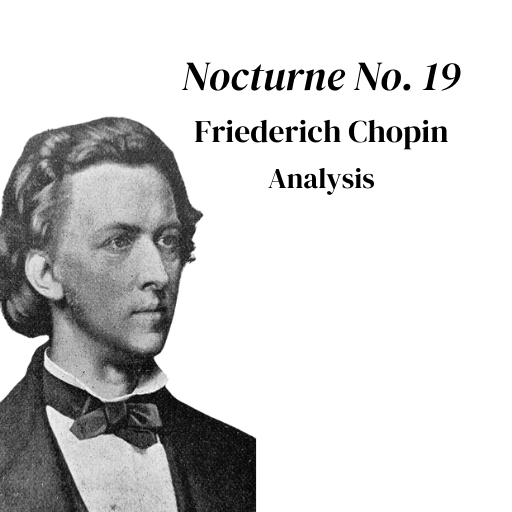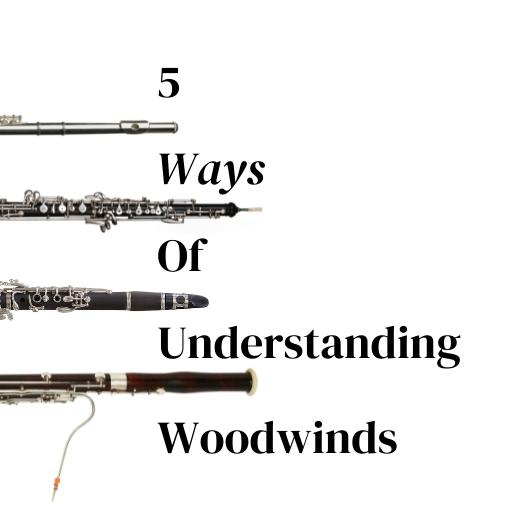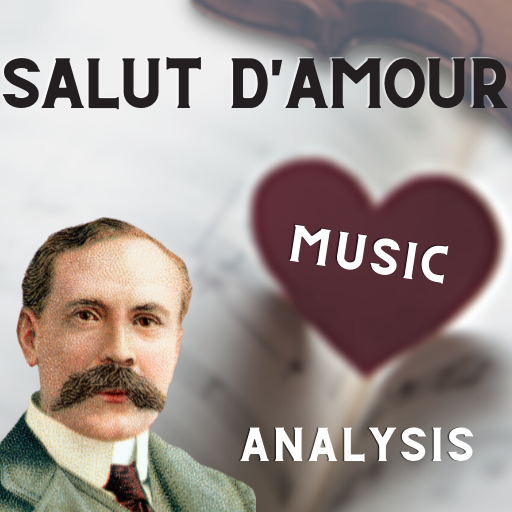To the point, I had not planned to create an analysis of this piece. However, I am currently working part time on a video game score and thought John Williams’ Gilderoy Lockhart theme could prove a useful model for a cue that I need to create. Whether it will prove the case, I don’t know, as the characters are not identical. However, I figured another composition analysis couldn’t harm my development! So, I figured I’d dive right in and share my analysis of John Williams’ Gilderoy Lockhart, focussing on the melodies presented in Hal Leonard’s The Chamber of Secrets Concert Suite.
Share with friends?

Why Gilderoy Lockhart?
To provide a bit of context, as the music is for the purpose of underscoring a character, I figured I best explain why I think John Williams’ Gilderoy Lockhart music might be useful to me. Basically, it boils down to some similarities between the two characters: the one I am writing for and Gilderoy Lockhart; and the way in which John Williams creates his music.
John Williams is a composer big on leitmotif. In his scores, he often wants significant places and characters to have music that supports them and reveals more about them, sometimes beyond the picture, to the cinema goer. In the case of Gilderoy Lockhart this is his fraudulent nature. As Villains Wiki points out, Gilderoy Lockhart “is a famous author and… Defence Against the Dark Arts Professor at the Hogwarts School of Witchcraft and Wizardry. Behind his alleged feats, however, Lockhart is nothing more than a fraud author who only seeks fame and brainwashes people into telling [him] their stories so he can pass them [off] as his own.” Revealed in the story/film (scene here), Lockhart attempts to brainwash Harry and Ron, using Ron’s broken wand. The wand backfires and casts the brainwashing spell on himself, confirming his fraudulence but giving him his comeuppance too.
In the video-game I am scoring, the character is different but carries elements of pomposity and fraudulence. Currently named Ronnie Barker, in tribute to the great comic actor, the character in the video game is based on Barker’s creation Arkwright from the series Open All Hours. A shop owner, the character I am underscoring is described in the brief as “a bit of a con man and cheapskate.” As I say, not the same, but I hope to pick up some comedic qualities from Williams’ score for Lockhart, which might help me make something better for my project. (Who better to learn from, than Mr Williams!)
Making Mozart Scary
The Art of Composing for String Quartet: A Guide for Beginners
Anatomy of the Orchestra by Norman Del Mar (Book Review)
“How do I orchestrate a piece of music?” (5-tips.)
Nocturne No. 19 in E-Minor, Op. 72 No. 1 (Analysis) – Friederich Chopin
Gilderoy Lockhart – John Williams (Impromptu Melodic Analysis)
The Lark Ascending (Music Composition Analysis) – Ralph Vaughan Williams (Article 1 – Lessons in Harmony)
How to repeat melodies without them getting boring… [Video]
5 ways of Understanding woodwinds
Arabesque No. 1 – Claude Debussy (Music Composition Analysis)
Spiegel im Spiegel – Arvo Pärt
Salut D’amour – Edward Elgar (Music Composition Technique Analysis)
Melodic Overview
In the Hal Leonard concert suite there are two main melodies presented in the Gilderoy Lockhart movement, as well as a vamp form idea that occurs in the film regularly and introduces the movement here. I present these three melodies below.
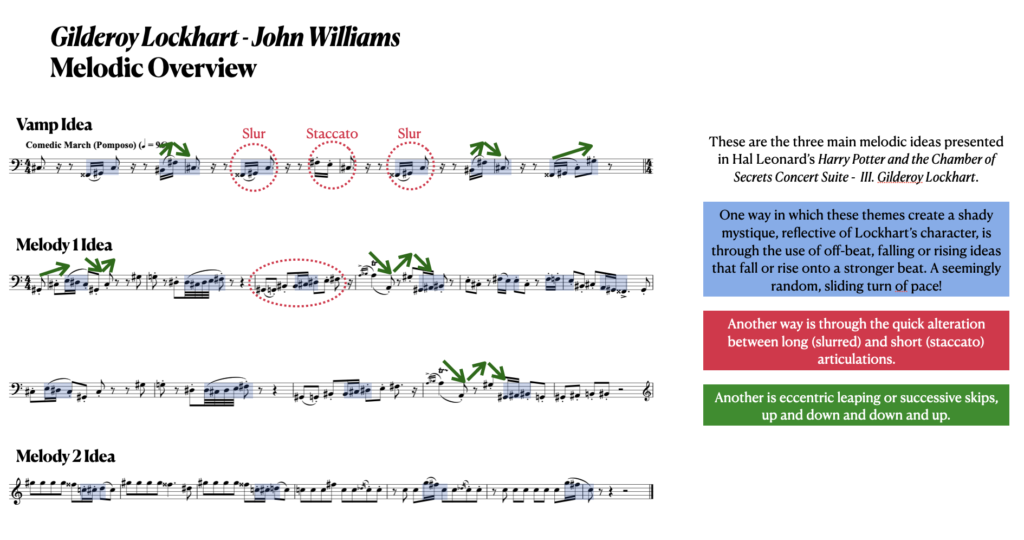

Overall, the melodies are “comedic” (to steal the performance marking). They have what I like to call iambic qualities. What I mean by this is that there are notes and gestures that fall or rise, often chromatically, onto a stronger beat, from a syncopated beat division. This gives the melody a lurching or slinky propulsion. Usually, in the melodies, the strong beats are beat 1 and 3. Although, melody 2 does play with this by rising to beat 4 and melody 1 to beat 2, in places.
Like the word above, the a of a-bove, leads on to a stress, the “b”, within the word, propelling us forwards. This is an iambic stress. Whether it really carries over to music is debatable, but I like to think of it this way. A great example of this style of writing, in a comedic setting, is The Pink Panther Theme.
What I love about Williams in this piece, along with others, is the precision with which he engraves the music, adding to its character. Always short, rather than long rhythmical values, there are frequent juxtapositions between short and long articulations such as staccato and slurs. For example, in the Vamp, Williams alternates a slurred and staccato figure that leads between bars, onto the down beat (beat 1). Moreover, he instructs a dotted quaver on beats 1 and 3, asking the players to hold the note slightly longer, giving it more weight, yet not long enough to fill the beat (still detached).
The melodies, within themselves and as a collective, juxtapose extremes of qualities. One of those is the legato and staccato gestures that we mentioned. However, there are others. For example, within themselves they often leap around, presenting gestures in different registers.
These melodies also have leaps that do not compensate themselves in the manner of what we would call “good melodic practice”. Leaping upwards, they’ll often leap straight back again rather than stepping inside. This adds to the comedic effect, I think, as we have grown to expect a melody to step rather than leap back again.
Vamp Idea
The vamp/introduction idea highlights an important harmonic quality in the music: a tritone. The F-double sharp in this instance forms an augmented 4th against our tonal centre C, and the B-sharp against F# forms a second. A distinctive interval, Williams is careful to emphasise it heavily here.
Tritones are pretty versatile intervals, creating instability that can be seen as dangerous in an evil or comical sense. In this setting, by creating the angular and short motivic ideas, which bounce around a lot, the effect is carefully crafted comedy.
As I mentioned in the overview, Williams is precise in adding slurs and staccatos to rhythmically short figures. In this situation, I think the counterpoint between long and short serves to emphasise the pointedness of the staccatos.
Lastly, this short idea emphasises the aimlessness and hollowness of all the melodies. Each idea going back to C#, the music does not go anywhere, it just orients around the centre. Perhaps, the C# is a representation of Lockhart’s narcism and self-centredness?
Making Mozart Scary
The Art of Composing for String Quartet: A Guide for Beginners
Anatomy of the Orchestra by Norman Del Mar (Book Review)
“How do I orchestrate a piece of music?” (5-tips.)
Nocturne No. 19 in E-Minor, Op. 72 No. 1 (Analysis) – Friederich Chopin
Gilderoy Lockhart – John Williams (Impromptu Melodic Analysis)
Melody 1 Idea
Melody 1 idea is the most substantial. It too does many of the things that the vamp does. For example, it juxtaposes long and short articulations. It has syncopated anacrusis gestures that slide onto main beats. However, that being said, it rarely comes to a rest on the strongest (first) beat of the bar.
The first melody idea is also aimless, like the vamp. It orients around C# again, falling back to it regularly through the melody. However, if we take C# as the centre, its aimlessness comes more from melodic cadences that are rarely on scale degree 1 (C#), and frequently left hanging on beats 3 or 4. For example, bar 2, beat 3, the phrase ends on F#, which is scale degree 4. In bar 4, beat 4, the melody rests on the raised 7th scale degree, B#. Phrase 3 ends on an F-double-sharp (#4); Phrase 4 is the same as phrase 1 (scale degree 4/F#); and phrase 5 ends on B#/the raised 7th again.
The other interesting, comedic quality of this melody is its chromaticism. Often this occurs through the presentation of the augmented-4th or diminished-5th, which is often fallen onto from G#. However, Williams also makes use of the raised-7th, which is a frequent harmonic and melodic chromatic note in minor keys.
My favourite piece of chromaticism comes in the middle section of this melody, where Williams juxtaposes two similar motivic gestures, with slight chromatic alterations. In bar 5, beat 2 to 3, and then bar 5 to 6, beats 4 to 1, we get a pair of off beat semi-quavers falling onto an E. In the first figure the sequence is simply an F# falling to an anticipatory E. In the second, however, the F# falls to the E via an F-natural. So subtle, the juxtaposition sounds comically wrong—like a mistake.
The last point I want to make about this melody is the way it leaps around. There is a lot of stepwise motion, within the more elaborate, ornamental parts of the melody. However, there are a lot of skips and leaps too. For example, the trill figure in bar 4 and 10. Falling an octave from A to A, the melody leaps back up to G#, a major-7th, before falling back down an octave. Similarly, the very opening to the melody is a pair of skips upwards. These give the theme a comic eccentricity and excitability.
Melody 2 Idea
The last melody idea, melody 2, is shorter. However, it reinforces much of what has been created by the other melodic material. For example, the repetition of notes and limited pitch material gives a sense of aimlessness again. Not going anywhere, it is all surface level intrigue for Mr Lockhart.
Again, the shady tritone is emphasised again, between F-double-sharp and C# in the first half of the melody and then F# and C-natural in the second. If we can describe a melody as dissonant, the C-natural certainly comes across that way. Tense, we probably hear it more as a B#: the raised leading tone. In combination with the F# we have the tension of a tritone that we want to hear resolve. Just like the others, it doesn’t.
Reflection and other observations
I have focussed on melody in this analysis. However, much of Lockhart’s underscore is monophonic. Chordal harmony occurs sparingly, as if withholding information about his character. We have to infer from the chromatic, shady melody that tippy-toes about, on pointed foot and up and down, the music is hiding its intentions. Moreover, predominantly on strings, the woodwinds and only horns, of the brass section, emerge. The heavy brass too heavy, a trickster needs to be light on his feet. (A pity my video-game score is only featuring brass, though it is a light-footed chamber ensemble!)
I am not sure where I will take my video-game theme, and how much it will take from Williams’ melody. As I said earlier though, there are few better to learn from than John Williams, when it comes to writing underscores. Therefore, I hope to take some of his sage wisdom: be it “the iambic rhythmic gestures”, the directionless lack of substance, or the chromaticism. Hopefully I can create something as pompously goofy as Gilderoy Lockhart.

